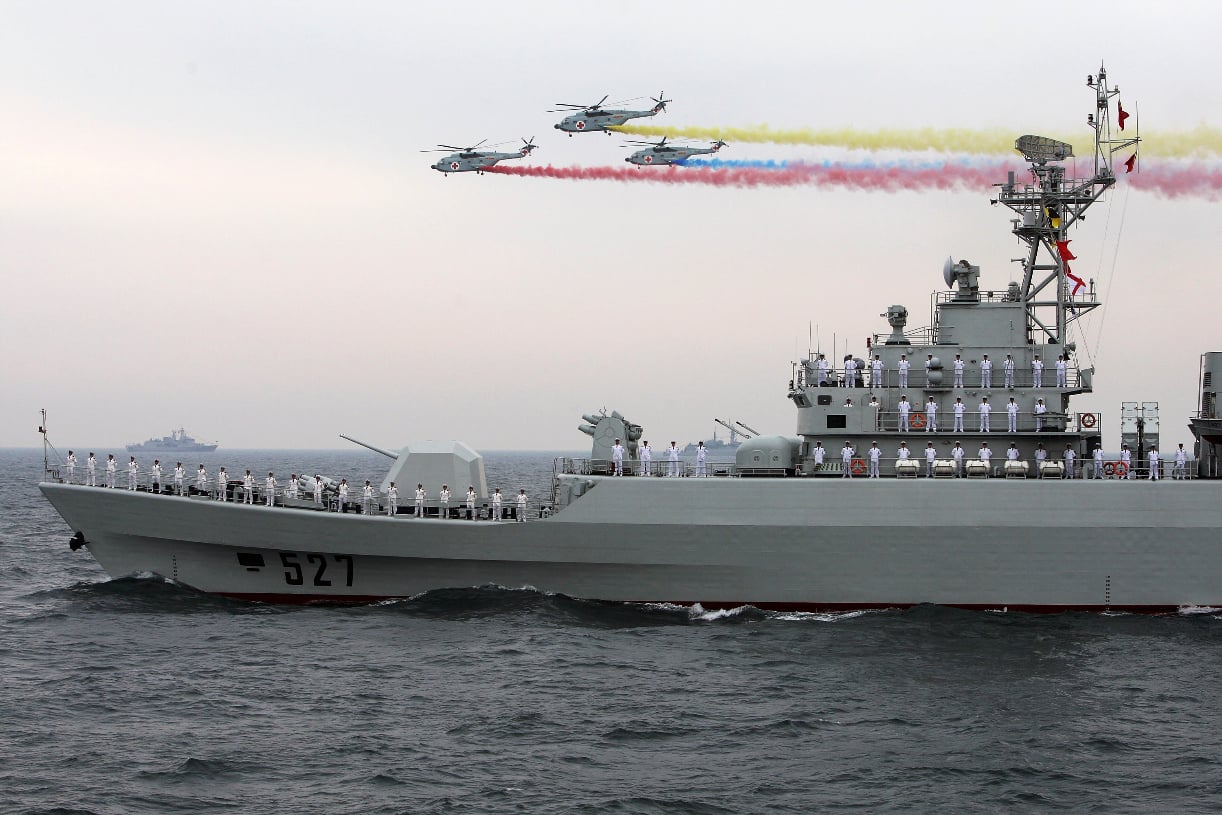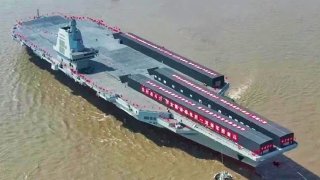China's Navy Is Growing More Powerful By the Day
China’s Navy is increasingly footloose—including its aviation component. Backed by an impressive armory of shore-based weapons, the fleet need no longer be closely tethered to defense of home waters and skies.
China’s surface fleet is increasingly footloose—including its aviation component. Backed by an impressive armory of shore-based weapons, the fleet need no longer be closely tethered to defense of home waters and skies. It can be more venturesome and range farther from home. It’s even possible China will found a standing expeditionary for some important expanse like the Indian Ocean.
Take notice, Asia.
Exhibit A: the aircraft carrier Fujian, China’s third flattop, departed for its initial round of sea trials on May 1 and remains at sea as I write. Much has been made of the technological advances manifest in the new carrier. It displaces more than its predecessors Liaoning and Shandong, for one thing. Shipwrights dispensed with ski jumps for launching aircraft, opting for catapults. As a result the vessel has the lines of a supercarrier of U.S. vintage, sporting a flat flight deck. Indeed, the ship reportedly features electromagnetic catapults and arresting gear—suggesting that the People’s Liberation Army Navy (PLA Navy) has staged a leap to parity with the U.S. Navy on certain technologies.
If so, that’s an impressive engineering feat. Only recently did USS Gerald R. Ford, the first U.S. carrier incorporating electromagnetic launch, recovery, and weapons elevators, complete its first major overseas deployment after being commissioned in 2017. Gee-whiz tech was that tricky to master. And yet Chinese naval architects may well have pulled it off.
Two Fujian-related points about fleet design, one about fleet tactics, and one about maritime strategy on a grand scale. First of all, fleet design. The PLA Navy now has enough aircraft-carrier hulls—or verges on having, assuming Fujian proves out—to keep one or even two carrier groups at sea at all times should the high command ordain. The Pentagon estimates it takes 1.5 carriers permanently forward-deployed to Japan to keep one on cruise at all times, factoring in the cycle of training, upkeep, and overhaul. With a 3:2 ratio between battleworthy and laid-up carriers, in other words, the PLA Navy is about to find its rhythm in carrier aviation, opening up new strategic vistas for the Chinese Communist Party regime in Beijing.
How the leadership uses a fully fledged carrier fleet in peacetime is worth monitoring for clues to how it will use the fleet in wartime.
It will also be worth watching to see what’s the next big thing in Chinese carrier aviation. One admirable thing about China’s naval buildup has been its openness to fleet experimentation. In the realm of, say, guided-missile destroyers, Chinese shipbuilders would construct several small classes or subclasses of warship, then turn them over to the navy to play with at sea. After evaluating each variant’s performance, the leadership would incorporate the best of each design and discard the worst. Synthesis gave rise to a platform fit for mass production, then Chinese yards went to cranking out hulls like sausages.
Chinese officialdom might find Fujian to be a satisfactory design to go into serial production. No, it’s not as big as U.S. Navy Nimitz- or Ford-class flattops, and no, it’s not nuclear powered. But it may not need to be to suit Beijing’s military needs as party leaders and military commanders construe them. In short, China may not need a 100,000-ton leviathan to accomplish its goals in the Indo-Pacific or even beyond (though Beijing might want one as an emblem of superpower status). Something humbler might do.
Ships are expressions in steel of ideas about national purposes, grandeur, and fighting prowess. What China builds next will say much about its ambitions and the image it wants to project.
Which leads to the point about fleet tactics. I recently attended a lecture at which a historian who should know better poo-poo’d the PLA Navy’s prospects vis-à-vis the U.S. Navy. The poo-poo’ing extended to the Chinese carrier fleet, the point being that because Chinese carriers are smaller than their American brethren, the U.S. Navy need not fret overmuch about the China challenge at sea. And there is just enough merit to that to beguile. Certainly in a high-seas clash between carrier fleets—a latter-day Battle of Midway remote from major landmasses—you would have to like the U.S. fleet’s chances. Relative tonnage is not entirely meaningless. Bigger carriers operate bigger air wings and thus can bring more firepower to bear at the scene of battle at the time of battle.
At the same time, though, tallying technical characteristics is a dangerously abstract way of measuring military potential. Battles do not happen on the pages of Jane’s Fighting Ships; they happen in real geophysical settings where real antagonists try to impose their will on one another.
The Indo-Pacific is one such setting. Simple carrier-on-carrier comparisons fundamentally misconstrue the nature of a future Western Pacific war in particular. Look at your atlas. The likeliest Pacific battlegrounds lie in the Taiwan Strait and the China seas. That’s where the PLA—including PLA Navy carrier groups—needs to bring decisive combat power to bear in order to succeed. There will be no Midways—no purely naval engagements—in these near-shore waters and skies. PLA Navy carriers will do battle under the shadow of the gargantuan, unsinkable aircraft carrier that is Fortress China. Land-based warplanes and missiles will add their fighting strength to the carrier fleet’s. After all, a unit of combat power is a unit of combat power, regardless of whether it comes from a warbird whose airfield floats or not.
Aircraft carriers are far from China’s only source of air power at places that matter.
Again, the point of operational art is to stage enough firepower at the scene of action and the time of action to overcome whatever the foe deploys. How U.S. Navy carrier groups backed by U.S. Air Force combat aircraft stack up against joint Chinese air power—not just Chinese carriers—is the question that truly matters. Chinese flattops could be adequate in the PLA’s overall battle scheme even if they never match the Nimitz or Ford in tonnage. And that’s good enough. They could prove adequate without reaching parity.
Let’s have no more disparaging a worthy opponent lest we talk ourselves into complacency.
And lastly, the point about maritime strategy. In his 1907 annual message to Congress, President Theodore Roosevelt explained the relationship between the U.S. Navy battle fleet and coastal defenses. (When he says “the Navy” he means the battle fleet. The president reported that the Great White Fleet was about to pass through the Strait of Magellan into the Pacific on its world cruise at the time he delivered his message.) He told lawmakers that “in time of war the Navy is not to be used to defend harbors and seacoast cities; we should perfect our system of coast fortifications.”
The coast, that is, should defend itself against hostile maritime forces prowling offshore.
TR went on to insist that “the only efficient use for the Navy is for offense.” To liberate the battle fleet from coastal defense, allowing it to pursue its true purpose, “the coast cities must depend upon their forts, mines, torpedoes, submarines, and torpedo boats and destroyers. All of these together are efficient for defensive purposes, but they in no way supply the place of a thoroughly efficient navy capable of acting on the offensive; for parrying never yet won a fight. It can only be won by hard hitting, and an aggressive seagoing navy alone can do this hard hitting of the offensive type. But the forts and the like are necessary so that the Navy may be footloose.”
A footloose fleet can pursue a major fleet engagement and, if it triumphs, exploit command of the sea to shape the war’s course afterward.

China has sent TR’s logic of the symbiosis between land-based and saltwater-based sea power into overdrive. Access denial was a rudimentary, short-range affair in 1907. Coastal gunnery, minefields, and superempowered small craft like submarines and torpedo boats could erect a buffer against hostile navies that ventured too close to American shores. Today, by contrast, the PLA has fielded armaments that can lash out with precision from Chinese soil against U.S. or allied forces scores if not hundreds or thousands of miles distant. Theodore Roosevelt never could have dreamt of such defenses. The more satisfied Chinese magnates are with their anti-access and area-denial defenses, and with the strategic situation in East Asia, the more footloose the PLA Navy surface fleet can be.
And the more expeditionary character its operations can take on.
Only then—to anchor an expeditionary fleet or fleets far from Chinese seacoasts—may communist leaders see an overriding need to invest in nuclear-powered carriers on par with America’s. Even apart from their fighting strength, these behemoths would manifest Chinese might and majesty—helping China establish itself as a truly global diplomatic and military power. How Fujian fares will reveal much about the trajectory of Chinese sea power.
And—one hopes—ways to counter it.
About the Author: Dr. James Holmes, U.S. Naval War College
Dr. James Holmes is J. C. Wylie Chair of Maritime Strategy at the Naval War College and a Nonresident Fellow at the University of Georgia School of Public and International Affairs. The views voiced here are his alone.


